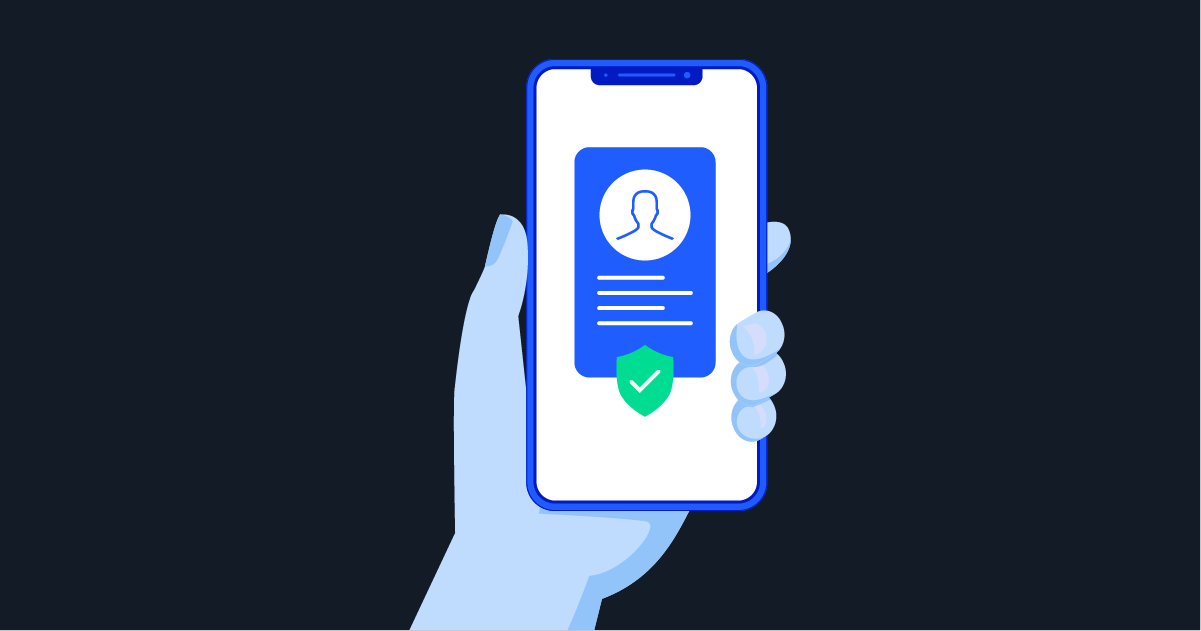
As digital threats grow and regulations tighten, businesses can no longer afford to treat compliance as an afterthought. In 2024 alone, global financial institutions were fined over $4.6 billion for failing to meet Anti-Money Laundering (AML), Know Your Customer (KYC), and Customer Due Diligence (CDD) compliance standards, with the U.S. alone accounting for more than 95% of these penalties.
This dramatically prioritizes a KYC onboarding solution for businesses as a necessity—serving as a frontline defense against financial and identity fraud. Beyond compliance, a solid KYC onboarding strategy helps build trust and enhance the overall customer experience.
As we progress through 2025, brands that want to stay ahead of rising security and privacy concerns need a robust, API-based KYC onboarding strategy. Telesign provides identity verification and fraud protection solutions to help simplify and secure the digital onboarding process.
This blog provides a comprehensive guide for businesses to understand and successfully implement the KYC onboarding process.
Table of Contents
What is KYC, know your customer?
KYC, (Know Your Customer), refers to the processes that banks, financial institutions, and other regulated entities use to verify the identity of their customers.
These protocols are essential in protecting against financial crimes such as fraud, corruption, money laundering, and other forms of criminal financing.
In many countries, including the United States, KYC and AML practices are mandatory. Under the Bank Secrecy Act (BSA), U.S. financial institutions are required to implement an ongoing KYC/AML program. Similar compliance regulations are in place across most major banking countries, each with its own set of KYC/AML rules.
Although KYC onboarding is closely linked to AML measures, the two serve distinct purposes. KYC primarily focuses on verifying the identity of customers, while AML offers a broader framework to prevent and detect financial crimes.
Main components of KYC
There are three primary components to the KYC process:
1. Customer Identification Program (CIP)
The CIP involves verifying a customer’s identity using documents such as government-issued IDs. Under the Bank Secrecy Act (BSA), financial institutions are required to have a CIP in place to confirm essential customer details, including name, address, date of birth, and government-issued ID numbers. Additionally, the customer’s name is checked against global sanctions lists and Politically Exposed Persons (PEPs) databases to identify potential risks.
2. Customer Due Diligence (CDD)
CDD is the process of collecting and analyzing further information about customers to better understand the nature of their business and assess any potential risks, such as involvement in illegal activities. This step includes customer identification, identity verification, selfie verification, address confirmation, beneficial ownership checks, and understanding the purpose behind the business relationship.
3. Enhanced Due Diligence (EDD)
EDD involves a more in-depth investigation, particularly when CDD reveals any unusual or suspicious activity that indicates heightened risk. This is typically required for high-risk customers, such as those from sanctioned countries, industries prone to illegal activities, or individuals with questionable financial histories.
Essential pillars of the KYC framework
A strong KYC framework is built on four essential pillars:
- Customer Acceptance Policy (CAP): Defines the standards and criteria for accepting a customer and establishing a business relationship.
- Customer Identification Procedures (CIP): Ensures that the individuals or entities being onboarded are accurately identified and verified.
- Monitoring transactions: Involves continuous monitoring of customer activity to detect suspicious behavior or patterns that may indicate financial crime.
- Risk management: Focuses on analyzing and evaluating the risk each customer poses throughout the duration of the business relationship.
What is the KYC onboarding process?
The KYC onboarding process is a set of critical procedures that businesses—particularly in the financial sector and other regulated industries—must complete before entering into a formal relationship with a new customer. It is a specific part of the broader client onboarding journey, focused on identity verification and regulatory compliance.
Key components of a KYC onboarding process
A robust KYC onboarding software or process includes several key components; each designed to verify identity and assess customer risk effectively:
Identity proofing
Identity verification is the foundation of the identity proofing process. It involves collecting core personal data—such as full name, date of birth, and government-issued identification numbers (e.g., a Social Security number in the U.S.).
For business customers, this step also includes gathering corporate registration documents, the company’s registration number (CRN), and details of ultimate beneficial ownership (UBO).
Document verification
Using AI-powered technology, this step checks the authenticity of submitted documents like passports or driver’s licenses. It analyzes features such as fonts, watermarks, and holograms. Proof of address (PoA) —such as utility bills, bank statements, or tax documents—may also be required.
Biometric verification
Biometric checks, including facial recognition and liveness detection, confirm that the person presenting the ID is its rightful owner. A selfie is compared to the photo on the submitted document, while liveness detection ensures it’s a real individual—not a static image or deepfake.
Phone and email risk analysis
Analyzing the risk associated with the customer’s phone number and email address can uncover red flags. This may include identifying virtual numbers, checking the age of the phone number, or flagging known associations with fraud.
Sanctions and watchlist screening
As part of the Customer Identification Program (CIP), customer data is screened against global sanctions lists and Politically Exposed Persons (PEPs) databases.
This helps identify individuals subject to legal restrictions or higher risk due to their status or associations.
Geolocation and IP intelligence
Gathering information about the customer’s geographical location and IP address supports identity verification and flags inconsistencies—such as mismatches between claimed and actual locations or high-risk regions.
Ongoing KYC: KYB and KYT
Initial KYC checks are just the beginning. For business clients, Know Your Business (KYB) procedures help assess corporate legitimacy. In parallel, Know Your Transaction (KYT) monitoring analyzes transaction patterns to detect unusual or suspicious activity over time.
Step-by-step guide for the KYC onboarding process flow
The KYC onboarding process typically follows a structured series of steps to ensure complete identity verification and regulatory compliance:
Step 1: Collecting customer data
This first stage involves gathering all required information from the new customer, including personal details such as full name, date of birth, address, contact information, and government-issued identification.
For business customers, it also includes corporate registration documents and ultimate beneficial ownership (UBO) details.
Step 2: Verifying customer identity
APIs and AI-powered tools are used to authenticate the submitted documents and information. This step includes document verification, biometric checks, and cross-referencing data with trusted databases. Digital KYC verification makes this process faster and more efficient.
Step 3: Assessing the potential risk
Once the customer is verified, a risk assessment is performed based on their profile and screenings against global sanctions and Politically Exposed Persons (PEPs) lists. Factors such as geographic location, industry, and behavior patterns contribute to the risk identified. If red flags are detected, Enhanced Due Diligence (EDD) is initiated.
Step 4: Conducting due diligence after onboarding
Due diligence doesn’t end after onboarding. Ongoing monitoring is critical to detect suspicious behavior, shifts in risk level, or signs of money laundering, terrorist financing, or fraud. In some cases, periodic reverification of customer data is also required.
Step 5: Compliance documentation and audit trails
Maintaining detailed records of the entire KYC onboarding journey—including customer data, verification steps, risk assessments, and any flagged activity—is essential for meeting compliance requirements. If suspicious behavior is identified, Suspicious Activity Reports (SARs) must be filed with the appropriate authorities.
How does Telesign ensure smarter and safer KYC onboarding?
Telesign offers a suite of powerful identity verification and fraud protection solutions that help businesses streamline and secure the KYC onboarding process:
- Phone ID: Telesign’s Phone ID verifies phone number ownership in real time, checking reachability, validity, and risk using global telecom data. It instantly identifies whether a number is active, linked to the user, or has been recycled—an important feature for protecting against account takeover and SIM swap fraud. The phone number deactivation check flags recycled numbers, helping reduce the risk of onboarding fraud using inactive or reassigned lines.
- Verify API: Telesign’s Verify API enables secure One-Time Password (OTP) authentication to confirm user identity during onboarding. Delivered via SMS, voice, or email, the OTP process ensures that the user in control of the provided contact method is the legitimate account holder—helping prevent unauthorized access and fraud. The API also includes real-time delivery status, fallback logic, and fraud analytics to increase reliability and conversion.
- Phone number intelligence: Telesign’s Intelligence enhances risk recommendations by providing real-time data, including phone type (mobile, landline, VoIP), carrier, country, roaming status, and activity signals. This helps businesses better assess user legitimacy, flag suspicious behavior, and optimize identity verification across customer touchpoints.
Together, these products offer businesses real-time risk intelligence for dynamic, data-driven decision-making during the KYC onboarding process.
Telesign’s solutions are easily integrated via REST APIs and SDKs, offering flexibility for development teams. The KYC API Suite is built to support compliance with global regulations such as GDPR and AML, helping businesses stay ahead of evolving privacy and security standards while delivering a seamless user experience.
Top use cases for the KYC onboarding process
Telesign’s KYC use cases highlight how businesses across industries are strengthening identity verification, streamlining customer onboarding, and reducing fraud. Each case study outlines the challenge, solution, and measurable impact.
- Amount streamlines eKYC and identifies 80-85% of self-service applicants
Industry: Financial technology
Amount is a leading fintech platform that helps banks and financial institutions accelerate digital transformation and deliver seamless omnichannel experiences. Their technology enables institutions to launch fully digital services in a matter of months—not years.
Use case context
Amount needed to add stronger security measures to its KYC onboarding process for digital originations—without increasing friction or slowing down the customer journey.
The challenge
Manual identity verification was creating unnecessary friction during onboarding. At the same time, rising fraud threats—especially in the shift from offline to online banking—demanded stronger, scalable verification methods.
The solution
Amount integrated Telesign’s Verify API into its product, Amount Verify. The solution uses SMS and voice-based one-time passwords to power a secure and efficient eKYC process—eliminating the need for manual checks or physical documentation.
The results
- Approximately 80–85% of applicants verified through a self-service process
- Higher conversion and account sign-up rates
- Reduced fraud risk and lower operational costs
- Improved customer experience and increased revenue
- AstroPay combats fake account creation with fast, secure onboarding
Industry: Online payments, e-Commerce
AstroPay is an online payment and e-Commerce platform serving over 9 million users worldwide.
Use case context
As AstroPay scaled rapidly, the company needed a reliable way to fight fake account creation and promotional abuse. A trusted global SMS partner was also essential to improve message deliverability and maintain a smooth onboarding experience.
The challenge
With the rise in online transactions, fraud became a growing concern—nearly 25% of new account sign-ups were fake. AstroPay needed to enhance account security without compromising the speed or ease of onboarding.
The solution
AstroPay integrated Telesign’s Trust Engine, combining the Phone Number Intelligence API to assess risk at the point of sign-up and the SMS API to send OTPs for user authentication. This enabled the business to evaluate legitimacy in real time and verify users efficiently.
The results
- Significant reduction in fake account creation
- Faster, more secure onboarding process
- Improved SMS deliverability and reliability
- Lower promotional costs and better ROI
- Increased ratio of active, verified users
- BigDataCorp enhances digital identity accuracy with integrated mobile identity solutions
Industry: Data technology, information services, IT
BigDataCorp is a leading Latin American data technology company, helping businesses in Brazil structure and enrich digital identity data products. Founded in 2013, the company plays a critical role in the region’s identity data ecosystem
Use case context
To strengthen its digital identity portfolio, BigDataCorp needed a scalable way to verify phone number ownership and assess risk—while maintaining strict data privacy and compliance standards in Brazil.
The challenge
BigDataCorp faced two key challenges:
- Managing fast-growing and diverse data sets with partners that uphold stringent compliance standards.
- Addressing the rising risk of fraud tied to phone numbers, such as SIM swap attacks and number spoofing.
To succeed, they required a mobile identity solution offering speed, precision, and full market coverage—delivered through low-friction integration.
The solution
BigDataCorp partnered with Telesign and integrated Phone ID, including advanced capabilities such as Contact, Subscriber Status, SIM Swap detection, Porting Status, and Porting History. These features were easily embedded into BigDataCorp’s low-code environment for fast deployment.
The results
- Seamless integration into existing workflows
- Comprehensive mobile identity coverage across Brazil
- Improved user validation and reduced fake account sign-ups
- Enhanced data accuracy by verifying phone numbers and identity attributes
- Strengthened overall digital identity product offerings
- Fiverr reduces unauthorized withdrawals by 60% with smarter user verification
Industry: Online marketplace
Fiverr is a global online marketplace connecting businesses with freelancers offering digital services across more than 400 categories.
Use case context
As Fiverr’s platform scaled worldwide, the company needed to build a secure environment for both freelancers and businesses. This meant reinforcing trust, especially around user verification and financial transactions.
The challenge
Relying on email verification alone left user accounts vulnerable to unauthorized access. Fiverr also faced challenges with duplicate accounts, fraudulent sign-ups, and a growing risk of unauthorized withdrawals of funds.
The solution
Fiverr partnered with Telesign and implemented two-factor authentication (2FA) using one-time passwords (OTPs) sent via SMS and voice. Over time, Telesign’s phone verification APIs became a core part of Fiverr’s security stack.
Fiverr also deployed the Phone Number Intelligence API to assess the risk level of new users, drawing on insights from Telesign’s Global Fraud Data Consortium for broader fraud detection coverage.
The results
- Reported 60% reduction in unauthorized withdrawals
- Enhanced platform security through multi-factor verification
- Improved ability to detect and block fraudulent or duplicate accounts
- Strengthened trust across the user base by protecting personal and financial data
- Giftnix combats eGift fraud and improves customer verification with intelligence
Industry: E-Commerce (online gift card store)
Giftnix is an online gift card platform offering instant digital delivery across a wide selection of gift cards. Security and trust are central to its customer experience.
Use case context
Facing a rise in fraud involving stolen credit cards and fake identities, Giftnix needed to strengthen customer verification without adding friction. Reliable communication and fraud detection became critical to protecting both revenue and reputation.
The challenge
Giftnix struggled to detect fraudulent activity before purchases were completed, leading to increased chargebacks and revenue loss. They also experienced issues with message deliverability through their previous communications vendor.
The solution
Giftnix integrated Telesign’s Phone Number Intelligence and SMS Verify products to create a multi-layered verification approach. Backed by machine learning, these tools delivered deeper insights into user behavior and phone number risk—while enabling secure, real-time communication with customers worldwide.
The results
- Improved customer verification with real-time risk analysis
- Fewer chargebacks from stolen credit card use
- Reliable global SMS delivery for mission-critical communications
- Stronger, more trusted digital identities
- Seamless international reach without impacting user experience
Why choose Telesign as your KYC onboarding partner
With digital threats on the rise and regulatory pressure mounting, modern businesses need a KYC onboarding partner that delivers both security and scalability. Telesign brings over two decades of fraud protection expertise and extensive industry experience, helping companies across Fintech, e-Commerce, telecom, and beyond verify identities, stop fraud, and support compliance.
Telesign’s API-first solutions are built for performance, designed with developers in mind, and backed by real-time, AI-powered risk intelligence. From validating phone number ownership with Phone ID, to detecting fraud signals through Intelligence, to seamless verification across the customer journey with Verify API, Telesign helps you authenticate legitimate users—without adding friction.
Trusted by global enterprises, Telesign helps reduce synthetic identity onboarding while enabling a seamless, secure onboarding experience. Businesses benefit from flexible deployment, transparent pricing, and compliance with key global standards—including GDPR, CCPA, ISO 27001, and support for international identity documents.
If your organization is looking to future-proof customer onboarding, reduce fraud, and strengthen trust from the very first interaction, Telesign offers the tools and expertise to make it happen. Talk to our experts today to explore how Telesign can support your KYC onboarding strategy.
Frequently asked questions
Secure KYC onboarding is critical for industries such as finance, fintech, e-commerce, telecom, gaming, and insurance. AML-regulated sectors—including financial services, iGaming platforms, Virtual Asset Service Providers (VASPs), and real estate—are required to implement KYC procedures to stay compliant and mitigate fraud.
Non-regulated industries, like car-sharing services and online marketplaces, also benefit from secure KYC onboarding by strengthening user trust and preventing identity-related risks.
Yes. KYC can be fully automated using APIs—like Telesign’s—that support real-time identity verification while maintaining a full audit trail for regulatory readiness. Automation streamlines the process by verifying documents and data instantly, helping businesses reduce costs, improve accuracy, and speed up onboarding without compromising compliance.
With solutions like Telesign, digital KYC verification can be completed in seconds. Telesign’s API typically processes identity checks in under 5 seconds, enabling businesses to complete secure KYC onboarding in under a minute. Automation helps streamline the entire process—reducing friction while maintaining compliance.
KYC (Know Your Customer) focuses on verifying the identity of individual users, typically in a B2C context. KYB (Know Your Business), on the other hand, applies to B2B onboarding and involves verifying a business entity. KYB checks include reviewing corporate registration documents, the company’s registration number (CRN), and identifying ultimate beneficial ownership (UBO) to assess risk and ensure compliance.
Secure KYC onboarding helps mitigate fraud by ensuring that only real, verified individuals can access your platform. By verifying identities at the start of the customer journey, businesses can block synthetic identities, detect suspicious behavior early, and reduce the risk of unauthorized access. KYC also supports ongoing fraud protection through continuous monitoring and risk analysis.
Telesign verifies customer identities using a combination of phone number intelligence, SMS verification, and phone data analysis. The Phone ID API uses mobile identity signals to confirm ownership, detect number deactivation, and analyze risk. It also provides real-time risk recommendations using subscriber attributes—helping businesses verify users accurately and block potential fraud.
Yes. Telesign’s solutions support compliance with key global regulations, including GDPR, the EU Anti-Money Laundering Directives (AMLD), the California Consumer Privacy Act (CCPA), and other financial compliance standards—helping businesses meet regulatory requirements while protecting customer data.
Yes. Telesign’s Intelligence helps detect synthetic identities by flagging abnormal phone behavior, spoofing attempts, and inconsistencies in identity data. These real-time signals make it easier to identify and block fraudulent users—helping businesses reduce synthetic identity onboarding and strengthen overall security.
The best tools for KYC compliance are automated solutions with features like AI-powered identity verification, biometric authentication, document verification, risk analysis, and ongoing monitoring, crucial for KYC compliance.
AI can help enhance customer onboarding by automating key steps such as extracting data from documents, matching selfies to ID photos, and detecting spoofing or document forgery. It also enables real-time identity verification, detailed customer risk profiling, and reduces the need for manual review—making the onboarding process faster, more accurate, and more secure.


